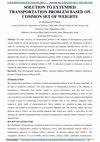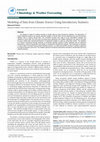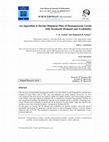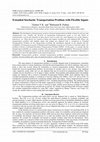Papers by Mohammed Banekhan Pathan

International Journal of Research and Analytical Reviews(IJRAR), 2019
The main objective of transportation problem is the shipping of homogeneous goods from various or... more The main objective of transportation problem is the shipping of homogeneous goods from various origins to various destinations. In classical transportation problem, the distribution of goods is made by considering only one quantitative characteristic per shipment link.However,in real life, it is observed that the decision about the distribution of goods is based on several factors. In this paper, the transportation problem is extended by considering multiple incommensurate inputs and outputs for each shipment link, known as extended transportation problem (ETP). Common set of weights approach is proposed to compute the relative efficiency of each shipment link. The shipment plan with maximum efficiency is considered as optimal solution to ETP. A numerical example is discussed in order to validate the applicability of proposed approach.

The attempt is made for building model(s) to climate data by using introductory statistics. The a... more The attempt is made for building model(s) to climate data by using introductory statistics. The application of
simple statistical methods can expose important insights in climate data. Various statistical tools from introductory
statistics help to analyze climate data. The correlation analysis also helps to study interrelations between the
variables in given data. The tools such as simple linear regression and multiple regressions are used to fit model
for given climate data. Estimation/Prediction of dependent variable is made by using fitted models. The reliability
of a model is discussed through residuals. A numerical example consists of three variables such as maximum
temperature, minimum temperature and rainfall is considered to illustrate the analysis. The importance of variables
in a given data is checked through simple statistical analysis. It is observed that 92% variation in rainfall is explained
by range temperature (max-min). The multiple regression models provides better estimate for rainfall rather than two
variable analyses.
The extended transportation problem has multiple incommensurate inputs and outputs for each shipm... more The extended transportation problem has multiple incommensurate inputs and outputs for each shipment link. Under uncertainty of variables such as demand and availability for each shipment link, the problem is considered as extended transportation problem with chance constraints. To solve such problem we consider each shipment link as a Decision Making Unit (DMU) and the relative efficiency concept is defined for it. The relative efficiency of each DMU is based on common set of weights (CSW). Multi objective linear programming approach is used to decide CSW. Hypothetical example is considered to study the applicability of the proposed approach.
The transportation problem with multiple incommensurate inputs and outputs for each shipment link... more The transportation problem with multiple incommensurate inputs and outputs for each shipment link is known as Extended Transportation Problem (ETP). Under uncertainty of variables such as demand and availability for each shipment link, the problem is considered as Extended Stochastic Transportation Problem (ESTP). To solve such problem we consider each shipment link as a Decision Making Unit (DMU) and the relative efficiency concept is defined for it. The relative efficiency of each DMU is calculated by using common set of weights (CSW) for input and output variables. Multi objective linear programming approach is used to decide CSW. The method to get shipment plan with maximum efficiency is suggested in this paper. Hypothetical example is considered to study the applicability of the proposed approach.
The transportation problem with multiple incommensurate inputs and outputs for each shipment link... more The transportation problem with multiple incommensurate inputs and outputs for each shipment link is considered as extended transportation problem. In the transportation problem, the distribution depends on the demand and the availability of homogeneous goods. Due to many reasons, demand and availability of goods may not be known. In our study, we assume that the demand and availability are random variables with some known probability distribution. We proposed a method based on data envelopment analysis to decide optimal shipment plan. The hypothetical illustration is considered to check the applicability of the proposed approach.

The decision of transporting homogeneous goods is not only based on unit transportation cost but ... more The decision of transporting homogeneous goods is not only based on unit transportation cost but also depends on many factors such as order size, total shipment-cost, profit, distance, manpower , etc. For each shipment link, these factors are treated as inputs and outputs variables. Such transportation problem with multiple inputs and outputs per shipment link is considered as Extended Transportation Problem. In the transportation problem, the distribution depends on the demand and the availability of homogeneous goods. Demand and Availability of goods may not be known to decision maker. Under this situation, the problem is known as Extended Stochastic Transportation Problem (ESTP). In this paper, we assume that the demand and availability are random variables with some known probability distribution. We proposed a method based on data envelopment analysis to decide optimal shipment plan for ESTP. The hypothetical illustration is considered to check the applicability of the proposed approach.

The distribution of homogeneous goods in classical transportation problem is based on only per un... more The distribution of homogeneous goods in classical transportation problem is based on only per unit transportation cost. Usually, the decision of transporting homogeneous goods is not only based on transportation cost but also depends on many factors such as order size, total shipment-cost, profit, distance, manpower , etc. These factors are treated as inputs and outputs variables for each shipment link. Hence, the transportation problem with multiple inputs and outputs per shipment link is considered as Extended Transportation Problem. In the transportation problem, the distribution depends on the demand and the availability of homogeneous goods. If Demand and Availability of goods are not known to decision maker, the problem is known as Extended Stochastic Transportation Problem (ESTP). In this paper, we assume that the demand and availability are random variables with some known probability distribution. We proposed a method based on data envelopment analysis to decide optimal shipment plan for ESTP. The hypothetical illustration is considered to check the applicability of the proposed approach.
We propose an extension to the classical transportation problem by considering multiple incommens... more We propose an extension to the classical transportation problem by considering multiple incommensurate inputs and outputs for each shipment link. The relative efficiency concept is defined for each shipment link. Two linear programming models are used to determine the optimal transportation plan with maximum efficiency. The applicability of the approach is discussed with a numerical example.
The main objective of transportation problem is to minimise the cost of shipping homogeneous comm... more The main objective of transportation problem is to minimise the cost of shipping homogeneous commodity from various origins to various destinations. The classical transportation problem is extended by considering multiple incommensurate inputs and outputs for each shipment link. The relative efficiency concept is defined for each possible shipment link. Two linear programming models are proposed to determine the optimal transportation plan with maximum efficiency. A numerical example is discussed to show the applicability of said approach.
The main objective of transportation problem is the shipping of homogeneous goods from various or... more The main objective of transportation problem is the shipping of homogeneous goods from various origins to various destinations. In classical transportation problem, the distribution of goods is made by considering only one quantitative characteristic per shipment link. However, in real life, it is observed that the decision about the distribution of goods is based on several factors. In this paper, the transportation problem is extended by considering multiple incommensurate inputs and outputs for each shipment link, known as extended transportation problem (ETP). Common set of weights approach is proposed to compute the relative efficiency of each shipment link. The shipment plan with maximum efficiency is considered as optimal solution to ETP. A numerical example is discussed in order to validate the applicability of proposed approach.






Uploads
Papers by Mohammed Banekhan Pathan
simple statistical methods can expose important insights in climate data. Various statistical tools from introductory
statistics help to analyze climate data. The correlation analysis also helps to study interrelations between the
variables in given data. The tools such as simple linear regression and multiple regressions are used to fit model
for given climate data. Estimation/Prediction of dependent variable is made by using fitted models. The reliability
of a model is discussed through residuals. A numerical example consists of three variables such as maximum
temperature, minimum temperature and rainfall is considered to illustrate the analysis. The importance of variables
in a given data is checked through simple statistical analysis. It is observed that 92% variation in rainfall is explained
by range temperature (max-min). The multiple regression models provides better estimate for rainfall rather than two
variable analyses.
simple statistical methods can expose important insights in climate data. Various statistical tools from introductory
statistics help to analyze climate data. The correlation analysis also helps to study interrelations between the
variables in given data. The tools such as simple linear regression and multiple regressions are used to fit model
for given climate data. Estimation/Prediction of dependent variable is made by using fitted models. The reliability
of a model is discussed through residuals. A numerical example consists of three variables such as maximum
temperature, minimum temperature and rainfall is considered to illustrate the analysis. The importance of variables
in a given data is checked through simple statistical analysis. It is observed that 92% variation in rainfall is explained
by range temperature (max-min). The multiple regression models provides better estimate for rainfall rather than two
variable analyses.